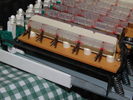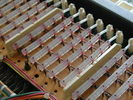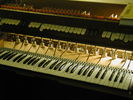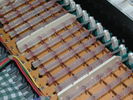
|
It's not necessary to clean the entire length
of the gold springs, but only the area where they make contact with the
gold
busses. This can usually be accomplished by depositing one drop of the
DeoxIT cleaner at the contact point with the contacts closed, then
operating the key a number of times. The DeoxIT cleaner
has a penetrating effect, and within hours or at most a few days it
spreads along the
entire length of the springs anyway. In fact, you will see red
dots of solvent (picture at left) surrounding the springs on the clear
plastic switch arms. Don't be alarmed, the solvent appears to be
compatible with the plastic. But if one or more dots don't appear
after a few days, check to make sure you treated those particular
springs.
|
|
|

|
If the contact springs are heavily oxidized, you may not see much if
any glimmer of gold at first. On my Swell keyboard, it seems that
copper has migrated through the gold layer and oxidized.
Initially it appeared that DeoxIT wasn't penetrating this layer, but
after two treatments one week apart, gold began to show through. Don't
worry if some parts of the gold springs or busses still look oxidized
-- what counts is how clean they are in the small area where contact is
made, and how well they work. |
|
|

|
After cleaning,
plug (or solder) in the keyboard and try it. If there are a few problem notes, try
just playing the organ for a few days then checking
again. Be sure to play in enough different keys so that you use all
the notes! Also, use the 16 foot stops or coupler some of the time and
play an octave higher so that you exercise the top octave. Play some
chromatic scales to make sure you hit everything. If you still have a
lot of bad notes after a few days of use, remove the keyboard and clean
all the
contacts again. If there are just a few bad notes, make a list and
concentrate on those. Don't apply DeoxIT Gold until you are happy with
the results; the cleaner is to get the contacts working, and DeoxIT
Gold is to keep them working. |
|
|

|
If there are problem notes that don't respond to two applications of
DeoxIT cleaner, strips of lint-free cotton cloth (available from Caig) can be
used to
lightly buff the contact area. I generally cut these to about 3/8" or
1/4" width, then gently pull them through the contact area with the
contacts lightly closed. It may be necessary to apply more DeoxIT
cleaner and to do
this several times.
If desired, more oxide can be removed from the non-contact surface of
the gold busses by wetting the tip of a cotton swab with DeoxIT
cleaner, then rubbing it along the busses. Be much more cautious
about cleaning the non-contact areas of the gold springs. If you
attempt it at all, be sure to use lint-free swabs and to apply almost
no pressure.
|
|
|
|
When you are ready to apply DeoxIT Gold, start
by applying a single drop at the contact point with the contacts
closed. As with the cleaner, the contact treatment will spread
along the springs of its own accord. If desired, you can use a
cotton swab to apply a thin layer of DexoIT Gold to the non-contact
areas of the gold busses.
|